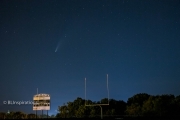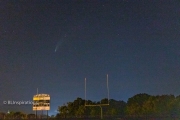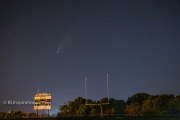By Laurie
The comet NEOWISE has recently been visible to much of the northern hemisphere. The comet, officially identified as C/2020 F3 is called NEOWISE after NASA’s space telescope Near-Earth Object Wide-field Infrared Survey Explorer which first identified the comet on March 27, 2020. The comet made it’s closest approach to the sun on July 3, 2020 at a distance of about 27,000,000 miles (perihelion) and it’s closest approach to the earth is July 23 at about 64,000,000 miles. The orbit of NEOWISE is parabolic and it’s farthest distance from the sun is about 66,000,000,000 miles (for comparison, Pluto’s average distance from the sun is about 3,700,000,000miles). NEOWISE won’t return to the inner solar system for about 6800 years.
Comets are often nicknamed “cosmic snowballs,” because they are icy, rocky objects made up of ice, rock and dust. They orbit the sun, and as they approach the sun, most comets heat up and material consisting of dust and gas is pulled away from the body, forming the visible “tail” which points away from the sun. NEOWISE is about 3 miles in diameter and it is estimated that the amount of ice in the comet is 7.8 cubic miles, about 55% of the comet’s volume. At this time the comet is traveling at about 40 miles per second (about 144,000 mph) but it will slow down as it draws away from the sun.
So far this summer, we’ve only been able to view the comet twice because of cloudy evenings. We took camera equipment last Sunday night to attempt to photograph the comet only because I read an online article about a way to photograph the comet that would reduce the noise of night photography with the high ISO speeds needed to avoid “star trails” from long time exposures. Other than a few full moon photographs, most of my attempts at night photography have not been successful due to the noise in the images.
This technique involves taking multiple exposures at high ISO values and “stacking” them with software that cancels most of the noise. A more detailed explanation can be found on our Definitions and Apps page.
The featured photo was created from 22 images and combined into one by stacking software to reduce the noise. In the Additional Images section below is another created from 10 images taken with longer exposures and lower ISO as well as one image at each setting processed normally to illustrate the noise without the use of the stacking software. All photos were taken from the track behind Broadway High School.
Additional Information
Questions and Answers about Comet NEOWISE: space.com
Information about Comet NEOWISE: wikipedia.com
A Beginner’s Guide To Photographing Comet NEOWISE: PetaPixel
Additional Images
Technical Information
NEOWISE Stacked 1 (22 stacked images)
- Date: 7/19/2020
- Time: 10:29PM
- Camera: Canon EOS 77D
- Lens: Canon EF-S 17-55 mm f/2.8 IS USM
- Settings:
- Lens: 28 mm, f/2.8
- ISO: 6400
- Shutter: 1 sec
- Uncropped image is 6000 x 4000 px
- GPS: 38°36’29.3″N, 78°47’33.7″W
NEOWISE 2 (Image 2 of 22 from stack)
Date: 7/19/2020
Time: 10:29PM
Camera: Canon EOS 77D
Lens: Canon EF-S 17-55 mm f/2.8 IS USM
Settings:Lens: 28 mm, f/2.8
ISO: 6400
Shutter: 1 sec
Uncropped image is 6000 x 4000 px
GPS: 38°36’29.3″N, 78°47’33.7″W
NEOWISE Stacked 2 (10 stacked images)
Date: 7/19/2020
Time: 10:32PM
Camera: Canon EOS 77D
Lens: Canon EF-S 17-55 mm f/2.8 IS USM
Settings:Lens: 28 mm, f/2.8
ISO: 1600
Shutter: 6 sec
Uncropped image is 6000 x 4000 px
GPS: 38°36’29.3″N, 78°47’33.7″W
NEOWISE 23 (Image 1 of 10 from stack)
Date: 7/19/2020
Time: 10:32PM
Camera: Canon EOS 77D
Lens: Canon EF-S 17-55 mm f/2.8 IS USM
Settings:Lens: 28 mm, f/2.8
ISO: 1600
Shutter: 6 sec
Uncropped image is 6000 x 4000 px
GPS: 38°36’29.3″N, 78°47’33.7″W




